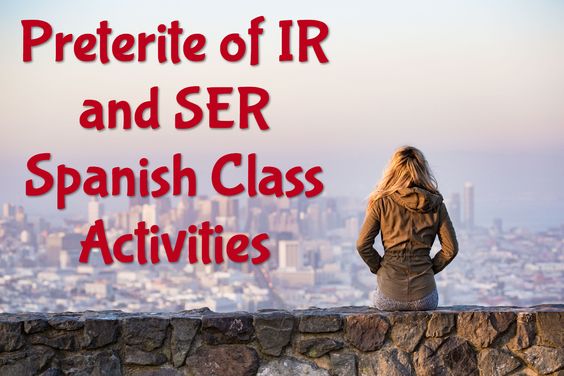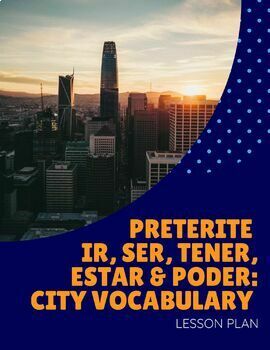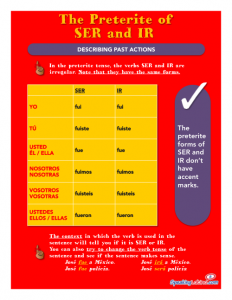
The preterite tense in Spanish is used to express past actions that are completed or finished. The verbs “IR” and “SER” have the same conjugation in the preterite, which can sometimes cause confusion.
In the preterite, “IR” and “SER” are both conjugated as follows: fui, fuiste, fue, fuimos, fuisteis, fueron. This means that the context of the sentence is crucial in order to determine whether the verb refers to the action of “going” or “being.”
For example, “Yo fui al cine ayer” means “I went to the movies yesterday,” while “Yo fui muy feliz en mi infancia” means “I was very happy in my childhood.” Similarly, “Él fue a la fiesta” means “He went to the party,” while “Él fue muy amable conmigo” means “He was very kind to me.”
Before learning the preterite of the verbs “ir” and “ser” in Spanish, a student should have a basic understanding of the following:
- Regular preterite tense: The student should be familiar with the regular preterite tense and its conjugations for -ar, -er, and -ir verbs.
- Irregular preterite tense: The student should also be familiar with the irregular preterite tense forms of other common verbs such as hacer, estar, tener, querer, and poder.
- Verbs “ir” and “ser”: The student should know that “ir” means “to go” and “ser” means “to be”. These verbs are irregular in the preterite tense and have unique conjugations.
- Stem-changing verbs: The student should be familiar with the concept of stem-changing verbs, as “ir” and “ser” have stem changes in the preterite tense.
- Vocabulary: The student should have a basic vocabulary in order to form meaningful sentences and understand the context in which the verbs “ir” and “ser” are used.
Preterite of IR and SER Spanish Lesson Plan and Printable Poster
 Preterite IR, SER, TENER, ESTAR and PODER: City Vocabulary Lesson Plan for Spanish 2 – Students are exposed to the city vocabulary with an authentic travel video from Mexico City. At the end of the lesson, the students will have learned and used vocabulary related to the city. They will be able to give directions to reach a specific place and move from one point to another. In addition, they will have learned and used in context the verbs “ir”, “ser”, “tener”, “estar” and “poder” in past tense.
Preterite IR, SER, TENER, ESTAR and PODER: City Vocabulary Lesson Plan for Spanish 2 – Students are exposed to the city vocabulary with an authentic travel video from Mexico City. At the end of the lesson, the students will have learned and used vocabulary related to the city. They will be able to give directions to reach a specific place and move from one point to another. In addition, they will have learned and used in context the verbs “ir”, “ser”, “tener”, “estar” and “poder” in past tense.
 Handout and Printable Poster – Verbs SER and IR in Preterite – Display this poster with two of the most common irregular verbs in your classroom. Available in three sizes: letter, legal and tabloid. Use the letter size as a handout for your students.
Handout and Printable Poster – Verbs SER and IR in Preterite – Display this poster with two of the most common irregular verbs in your classroom. Available in three sizes: letter, legal and tabloid. Use the letter size as a handout for your students.
